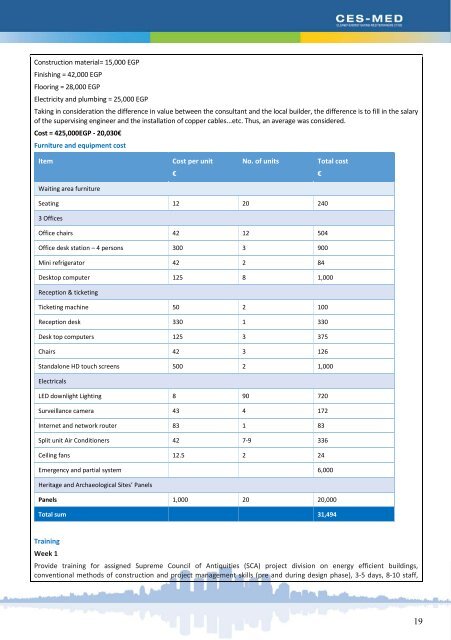280218_Luxor-Egypt SECAP Final_revised
You also want an ePaper? Increase the reach of your titles
YUMPU automatically turns print PDFs into web optimized ePapers that Google loves.
Image 14: Part of the encroachment can be seen along the green belt on the waterfront<br />
4.3 Heritage Sites Management analysis.<br />
The rising subsoil water level is one of the most destructive elements threatening sites in <strong>Egypt</strong> today. It is<br />
caused by the effect of the constant abundant irrigation of agriculture, and other triggering factors, following<br />
the construction of the Aswan High Dam. This is combined in many cases with poor drainage systems. In the<br />
past, the seasonal flooding of the Nile meant that on one hand many monuments in the Nile Valley were under<br />
water for much of the year but, on the other, were drained when the inundation season was over, so that the<br />
soil remained dry for the remainder of the year. There has been no indication that this was particularly<br />
damaging to the stone monuments, yet they are now suffering extensively from the rising level of subsoil<br />
water.<br />
The result of this situation, in combination with the climatic extremes of the Nile Valley, is that all of <strong>Egypt</strong>’s<br />
open air monuments are now suffering from salt crystallisation, which is causing the stone to crack and flake.<br />
The damage is caused by salt traveling with the water through capillary action within the stone and when the<br />
water evaporates on the surface the salt remains and crystallises. When moisture is added again, either<br />
through further capillary action or through dew, it breaks the surface of the stone. Dew and condensation on<br />
the stones during cold nights also dissolve the salts near the surface of the stone; when the dew evaporates<br />
during the day the salt crystals reform and cause crumbling and flaking.<br />
Furthermore, the salts also affect the overall strength of the stone. The water in the Aswan High Dam has a<br />
high level of salt because of high evaporation, which has increased the salinity of the Nile. The evaporation at<br />
ground surface level leads to an accumulation of salt in the upper soil-strata, and, moreover, the sub-soil<br />
water itself also contains destructive impurities that seep into the monuments.<br />
Among visible side effects, a difference in moisture concentration can clearly be seen in the discolorations on<br />
the walls and columns of the stone monuments.<br />
Other major threats to the cultural heritage are intensive agriculture, uncontrolled urban development and<br />
poorly managed tourism. The problems with the expansion of agriculture are closely linked to those of the<br />
subsoil water, being one of the causes of its rising level. Another problem is that more and more land is<br />
reclaimed for cultivation. In a country like <strong>Egypt</strong>, so densely scattered with archaeological sites, this has<br />
resulted in the loss of a large number of unexplored sites, and their official or unofficial surrounding buffer<br />
zones.<br />
Some crops (like sugar cane) or their residues (rice) are burned, and consequently produce unhealthy fumes<br />
which can have a damaging effect on the archaeological remains; others require the use of toxic chemicals<br />
which travel with the water into the capillaries of the stone.<br />
Among the successful remedies to the problem of subsoil water are projects such as that at Karnak and in<br />
Cairo’s Coptic historical district, in which pumps are employed to lower the underground water levels.<br />
However, this method is very expensive and thus would require a large amount of funding if all monuments<br />
were to be treated in this manner. Short-term and less costly solutions include the digging of trenches around<br />
the base of monuments to stop water from seeping into the stone, giving them a chance to dry, as well as<br />
applying silicon compounds to the stone to bind its molecules together.<br />
The problems caused by urban development and tourism are many times closely related. For example, in <strong>Luxor</strong><br />
13

















